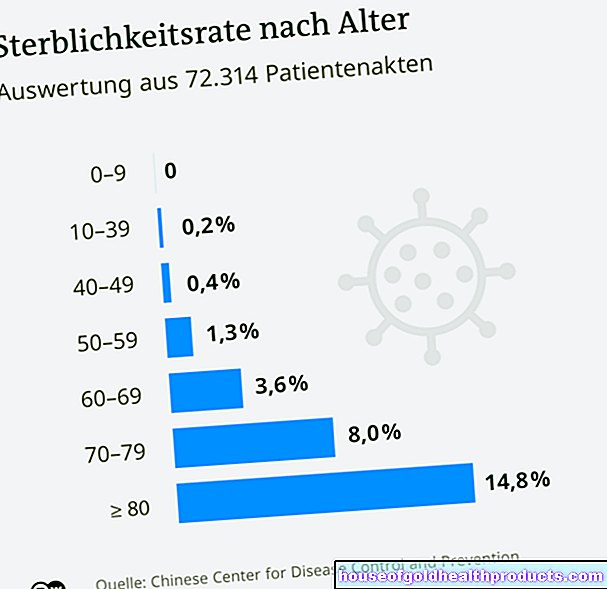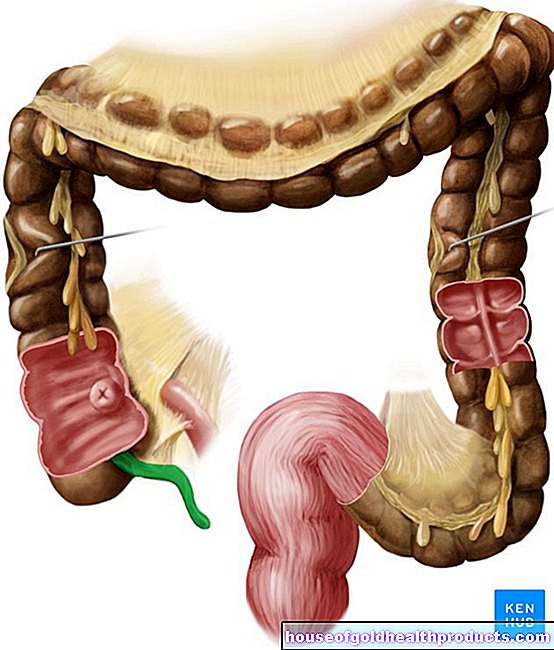Tetrazepam
All content is checked by medical journalists.The active ingredient tetrazepam helps against pathological muscle tension, anxiety and panic attacks, but has not been prescribed since August 1st, 2013. A comprehensive investigation by the European Commission showed that some people treated with tetrazepam developed severe skin reactions that were sometimes life-threatening or fatal. In addition, they were unpredictable and could occur at any point in treatment. Here you can read everything you need to know about tetrazepam.
This is how tetrazepam works
Mechanism of action
The human nervous system has various messenger substances (neurotransmitters) that can have an activating or inhibiting effect. They are usually in a balanced equilibrium and ensure an appropriate response to external circumstances such as rest or stress. One of these messenger substances, GABA (gammaaminobutyric acid), has an inhibitory effect on the nervous system as soon as it binds to its docking points (receptors). Tetrazepam increases the effect of this substance, which results in muscle relaxation (relaxation) and calming (sedation).
Occurrence and duration of the effect
The active ingredient is completely absorbed in the intestine. The tetrazepam effect can last for several days. Substances that arise after the active ingredient has been converted in the liver are also still effective.
When was tetrazepam used?
The areas of application (indications) of tetrazepam included:
- Panic attacks
- Spastic diseases of the nervous system (Little's disease, multiple sclerosis)
This is how tetrazepam was used
The active ingredient was mainly used in the form of tablets and drops. The tetrazepam dosage was 50 milligrams per day at the start of therapy. It could then be slowly increased to up to 200 milligrams per day. The dose had to be reduced in children from one year of age, adolescents, elderly patients and in patients with impaired kidney function.
Increases and decreases in the dose of the active ingredient tetrazepam always had to be gradual, that is, gradually over a period of several weeks.
What are the side effects of tetrazepam?
About one to ten percent of those treated developed characteristic tetrazepam side effects such as dizziness, drowsiness, coordination and speech disorders and gastrointestinal complaints after taking it. However, these complaints mostly subsided in the course of treatment. Occasionally (in 0.1 to 1 percent of those treated), allergic skin reactions and muscle weakness occurred. Serious skin reactions, menstrual disorders in women and decreased sexual desire (libido) were even rarer.
Another possible side effect was a reversal of the effect (paradoxical tetrazepam effect): although the active ingredient was actually supposed to have the opposite effect, paradoxically it could also activate the nervous system and, as a result, trigger states of excitement with fear, sleep disorders, aggression and muscle cramps.
What should be considered when taking tetrazepam?
Driving and using machines
The active ingredient tetrazepam leads to a significantly reduced ability to react. After ingestion, patients were therefore advised not to use heavy machinery or to actively participate in road traffic. This was especially true in combination with alcohol.
Addictive potential
Tetrazepam should only be used as briefly as possible, as it can be addictive after a short time. After stopping the drug (especially if the drug is suddenly stopped), sleep disorders and panic attacks could occur.
Interactions
There is a high potential for drug interactions. In particular, centrally effective drugs (psychotropic drugs, pain relievers, sleeping pills, allergy drugs) increase the effects and side effects of tetrazepam.
pregnancy and breast feeding period
Pregnant women were only allowed to receive tetrazepam after the doctor had carefully weighed the risks and benefits. In the last third of pregnancy in particular, taking it was considered critical, because after the birth of the newborn it could lead to "floppy infant syndrome". These are weaknesses in the newborn with poor drinking, slow breathing, reduced pulse, oxygen deficiency and muscle weakness. Instead, better researched drugs should be used. Ibuprofen and diclofenac (up to the 30th week of pregnancy) are tried and tested alternatives.If necessary, the better-studied diazepam could also be used for a short time.
During breastfeeding, experts recommended the pain reliever ibuprofen or physiotherapeutic measures instead of tetrazepam.
Contraindications
Tetrazepam was not allowed to be used in certain cases, for example in the case of severe pathological muscle weakness (myasthenia gravis), breathing pauses during sleep (sleep apnea syndrome), severe liver damage and disorders of movement coordination originating from the spinal cord or brain (spinal and cerebellar ataxias). Other contraindications were drug, drug and alcohol addiction.
How to get medication with tetrazepam
Tetrazepam is no longer available due to the unpredictable, severe skin reactions. Existing therapies with tetrazepam should gradually be discontinued (i.e. by gradually reducing the dose over several weeks) and replaced by alternative therapies.
How long has tetrazepam been known?
Tetrazepam has been known for a relatively long time as a drug from the group of so-called benzodiazepines. Initially, the drug was used to calm down and relieve anxiety. The muscle-relaxing effect of the active ingredient was soon recognized. For a long time, it was used successfully for painful muscle tension. However, the risk of the severe skin reactions that could occur during treatment with tetrazepam soon became apparent. A comprehensive study by the European Commission finally came to the conclusion that the risks clearly outweigh the benefits of treatment with tetrazepam. As a result, the active ingredient has no longer been allowed to be prescribed in Germany since August 2013.
Tags: teeth healthy workplace pregnancy birth





























